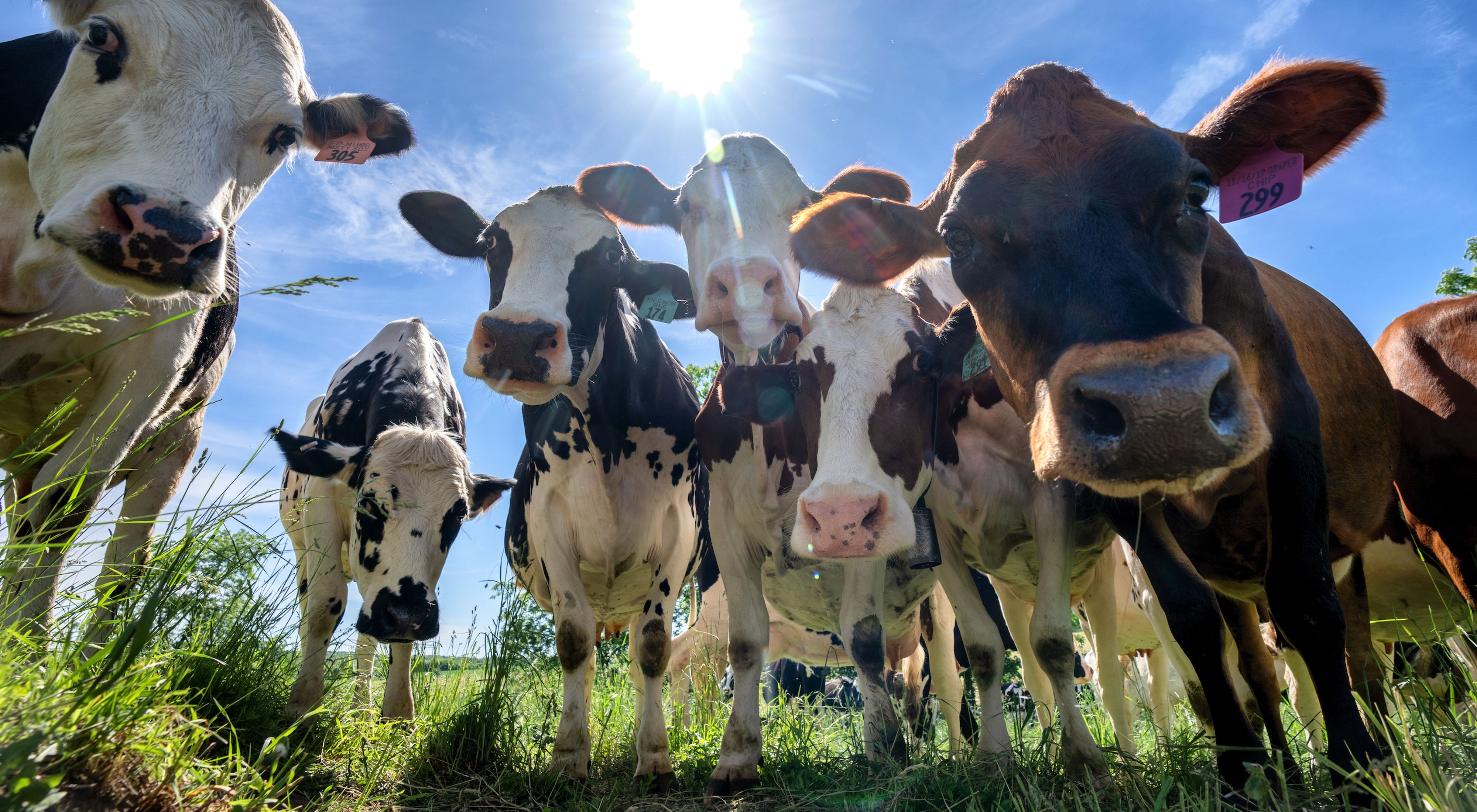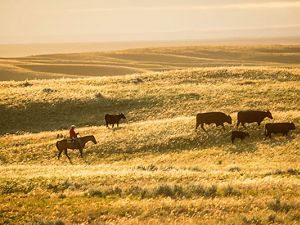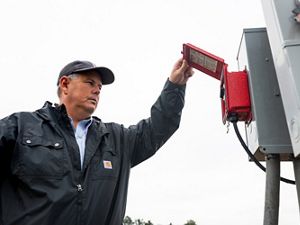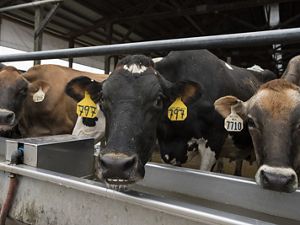Dairy Industry Aims for GHG Neutrality
TNC is working with partners to find climate solutions on dairy farms.
Dairy Sustainability Roadmap
Working Together Toward More Sustainable Dairy Production
Download the RoadmapThe agriculture and food industries are increasingly recognizing the inherent connection between a secure food supply chain, biodiversity, and a stable climate. The U.S. dairy industry is leading by example with an ambitious commitment to environmental sustainability.
The Innovation Center for U.S. Dairy set aggressive environmental stewardship goals—including achieving greenhouse gas (GHG) neutrality by 2050. To reach these goals, six national dairy organizations came together to form the U.S. Dairy Net Zero Initiative, an industry-wide collaboration to advance research and technology, on-farm pilots and new market development. .
“Dairy operations exist across the 50 U.S. states and are an integral part of the global food system,” says Alisha Staggs, director of The Nature Conservancy’s North America dairy program. “We are committed to working with the dairy industry and farmers around the nation to find and implement climate solutions while improving the resilience of the farms, the livelihoods of producers, and the lands and waters we all share.”
With Impact, Comes Opportunity
Growing crops for cow feed contributes to a dairy farm’s environmental footprint, yet most of an operation’s GHG emissions is methane from cow burps and methane and nitrous oxide from manure. Methane emissions—from a variety of sources including oil and gas, coal, agriculture and landfills—comprise one-fifth of all man-made GHG emissions, with enteric methane emissions accounting for 25% of cradle-to-grave GHG emissions by the U.S. dairy sector.
Thanks to improved farming practices, the carbon footprint of producing one gallon of milk shrank by 19% between 2007 and 2017, requiring 30% less water and 21% less land, according to a study published in the Journal of Animal Science. But there is still more work ahead.
In support of the Net Zero Initiative, TNC is teaming up with the Innovation Center for U.S. Dairy and other partners to identify, research, and implement regenerative practices that benefit dairy farmers and nature. Here are some of the projects we are working on:
Dairy Feed in Focus
Launched in 2021 by the Innovation Center for U.S. Dairy, Syngenta and The Nature Conservancy, the Dairy Feed in Focus (FIF) program is an industry-led effort to help improve feed production and feed efficiency on U.S. dairy farms, while reducing GHG emissions and contributing to improved water quality and soil health.
Farmers who enroll in the program are provided tailored technical support in choosing from a suite of best management practices, and then implementing those practices over three years. Practices include cover crops, reduced till and no till, crop rotation, nutrient stewardship, grazing and feed management, and edge of field practices. Farmers also receive incentive payments for practice implementation.
Since farmer recruitment began in Michigan and Wisconsin in 2022, TNC has worked with Foremost Farms and Michigan Milk Producers Association to enroll over 30 farmers and approximately 10,000 acres. These farms represent a total influence of over 42,000 acres and 23,000 dairy cows, with average farmer payments of around $14,000 annually. To date, the FIF team has fundraised more than $1.5M for farmer incentives in Michigan, Wisconsin, and Idaho. Nestlé USA is funding the incentives in all three states, and Rotary International District 6310 is funding the incentives for several farms in Michigan.
Download the Dairy Feed in Focus Practice Guidebook, a 27-page document that highlights the best management practices promoted through the program.
Theo Scholze, a dairy farmer in Wisconsin, was one of the first farmers enrolled. “Just about every decision we make, there is a financial side to it,” he says. “But if I can make changes to help the overall global environment, I feel it is my responsibility to do that.”
Participating farmers, like Scholze, are helping to create scientifically verified examples of the best agronomic and farm management practices that will serve as models for practice implementation on dairy farms of all sizes through the U.S. and beyond. Listen to a podcast about the Feed in Focus project.
Quote: Liz Hunt
Scalability is key to drive meaningful change and impact.
“Scalability is key to drive meaningful change and impact,” said Liz Hunt, Head of Sustainable and Responsible Business for Syngenta North America. “Our expectation is this project will deliver a blueprint for how to implement similar projects across the country, promoting shared learnings that benefit supply chains across the dairy industry.”
Innovative Feed Management Research
TNC, the Innovation Center for U.S. Dairy and the Institute for Feed Education and Research (IFEEDER) received a USDA award for $537,440 in 2021 to explore innovative feed management strategies that can reduce enteric methane emissions in dairy cows. With project partner resource contributions, the 3- year project will total more than $800,000.
Working with up to 10 dairy farms in Michigan and Wisconsin, this project combines on-farm trials and demonstrations of emerging technologies with strategic engagement of farmers, farm advisors, industry, carbon market players, and regulators for scaling the adoption of feed management strategies. The project is providing direct financial support to participating farmers to cover their costs of participation and as a direct incentive to participate.
“Feed rations and feed additives can significantly impact the carbon footprint associated with dairy, livestock and poultry production, and the feed industry is integral to developing and supporting these strategies for reduced GHG emissions on farms,” said Lara Moody, executive director of IFEEDER.
Dairy Sustainability Roadmap
TNC experts have developed a Roadmap for a Sustainable Dairy System to help the players within the dairy supply chain meet sustainability and environmental goals.
Based on scientific data about milk production practices, the guide can help farmers, processors, and retailers identify opportunities and make supply chain improvements, while tracking progress toward their environmental and other sustainability goals. Essentially, the Roadmap can help businesses create solutions that are both environmentally friendly and economically favorable, while delivering dairy products that consumers can feel good about.
Given the ambitious goal of the recent agreement between the United States and the European Union to reduce overall methane emissions by 30% by 2030, these projects could help U.S. dairy operations reduce emissions and have a significant impact across the industry.
Sustainability needs to be business-as-usual in the U.S. food and agriculture industries to ensure long-term food production, economic security for producers, and a healthy environment for us all.



